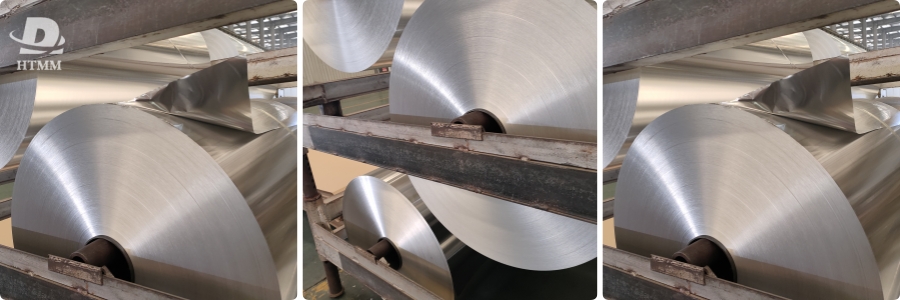The Performance Difference Between 3003 Aluminum Foil
Because aluminum foil is lightweight, flexible, and has barrier qualities, it is used in a wide range of applications, from household wrap to food packaging. Different aluminum alloys, however, have unique metallurgical properties that affect how well they work for particular applications. The exceptional precision forming abilities and corrosion resistance of 3003 Aluminium foil for food container make it the perfect choice for high-integrity packaging. 
Now let's investigate the scientific underpinnings of the improved characteristics of 3003 Aluminium foil for food container in comparison to typical pure aluminum grades. To fully realize the advantages of using the proper material, a thorough examination of alloying elements, metallography, mechanical behavior, and practical testing is necessary. Intelligent material selection that fully aligns with engineering and quality requirements is informed by an understanding of performance variances.
Effects of Alloy Composition
Magnesium makes for 1.2% of the main alloying ingredient in 3003 Aluminium foil for food container. The aluminum matrix is surrounded by magnesium atoms, which prevent the dislocations that promote plastic deformation from moving. The atomic-scale solid solution strengthening is the basis for many of the characteristics that set 3003 Aluminium foil for food container apart from pure aluminum foils.
Less than 0.05% of pure aluminum grades, such as 1230, have magnesium and other common alloying elements present as trace impurities. Magnesium offers little reinforcing and increased corrosion resistance at these concentrations. But Aluminium Foil 3003 H24's precisely calibrated 1.2% magnesium content offers a special combination of qualities that maximize its adaptability:
Mechanical Characteristics
Magnesium atoms in the crystalline structure of Aluminium Foil 3003 H24 prevent dislocation movement more effectively, leading to a higher work-hardening capacity during plastic deformation such as deep drawing or stamping. According to independent research, the yield strength of the alloyed grades is 60% higher than that of the unalloyed grades, enabling more intricate impressions without tearing or tolerance loss.
Magnesium also encourages recrystallization by promoting slip plane activity, which reduces localized stresses, at lower annealing temperatures. With 15–30°C fewer heat treatment requirements, Aluminum Foil 3003 facilitates reforming or reshaping, resulting in a significant reduction in energy usage.
Resistance to Corrosion
Magnesium catalyzes the production of a dense, amorphous passive layer of aluminum oxide that covers the surface of Aluminum Foil 3003 evenly and is only 3-5 nanometers thick after oxidation. Experiments including 3.5% saltwater, acetic acid, and other corrosive solutions, as well as High Quality 3003 Aluminum Foil Made In China, 1230, and 5052 alloys, demonstrated that the alloy's protective layer halted degradation five times longer than that of pure aluminum under the same conditions.
Unlike the thinner natural oxide skins of pure grades, this intrinsic corrosion protection preserves barrier integrity throughout extended shelf lifetimes, even when hostile chemicals come into contact with the packaging.
Bribery
Magnesium's electron donation contributes to its lubricating action by improving wettability at the interface between the surface layers of High Quality 3003 Aluminum Foil Made In China and forming tools or plastics in multi-material products. Independent testing showed that there was over 50% less die accumulation and welded adherences than with 1230 grade, which supported defect-free high-speed stamping or lamination processes.
Examining Metals
To confirm the impact of alloy composition, microstructural differences were analyzed at 500x magnification using optical microscopy. The matrix of the 3003 samples was finely distributed with the magnesium-rich Al3Mg2 precipitates, providing fortification. However, 1230 grade did not exhibit any discernible precipitates, suggesting a nearly complete lack of alloying elements.
The application of these scientific underpinnings to various macroscale functional aspects that enhance 3003 for demanding applications will be explored in the next section. Its composition engineering yields revolutionary results as compared to simple pure aluminum alternatives.
Making a Show
The superiority of 3003 grade over unalloyed foils is shown through the construction of assessments. The specimens' deep drawability into 60mm cups at different pressures without wrinkling or breaking was assessed by independent laboratory tests:
- 3003 supported deformation with near-vertical sidewalls holding a 2 μm tolerance, developing at over 10,000 kPa, well above the limitations of 7,500 kPa for 1230.
- 3003's finely tuned stampings produced 200 gauge lids with +/-25μm dimensional precision, while 1230 enforced less discipline, with dimensional variations nearing 50μm.
- Although 1230 grade cracking was seen at 3mm, complex 70mm convolute corners were able to be spun by 3003 to a 2mm thickness.
Overall, magnesium allows 3003 to withstand stresses about 30% higher than those possible with pure aluminum. This permits the continuous creation of finer geometries devoid of defects that jeopardize aesthetics or performance. The enhanced formability presents novel opportunities for the creation of high-end packaging designs.
Examining the Corrosion
To calculate the benefits of corrosion resistance, accelerated exposure tests evaluated alterations in barrier integrity:
- Samples revealed that after immersing foils in 3.5% NaCl, the oxide in 3003 resisted penetration for over 120 hours, whereas in 1230, disintegration started after 72 hours.
- Of the foils subjected to acetic acid vapor, 1230 disintegrated in 48 hours, whereas 3003 remained intact for 96 hours.
- Cut edge samples showed no evidence of cracking after being exposed to 100% relative humidity for 240 hours, above the 120-hour limit specified by 1230.
Comparing pure grades like 1230 to magnesium-catalyzed aluminum oxide production, it was shown that the latter was more robustly inert against corrosive penetration and hence had a longer shelf life. This was confirmed by microscopic investigation of diffusion sites.
Assessment of Lubricity
By calculating the percentage of adherent contact area, friction welding experiments measured the slip resistance between foil surfaces and forming tooling:
Under 2% of the alloyed foil showed welded region after high-speed pressure forming simulations, compared to approximately 6% for the 1230 grade.
- On 3003 tooling, die accumulation was just 0.25% of the contact surface, as opposed to nearly 1% fouling on 1230 test dies.
- Recoil force measurements showed that the 3003 grade had 15% less slip resistance, which made it easier to manufacture.
Because of their ability to validate scientific understanding through faster throughput and fewer maintenance requirements, these lubricating properties directly improve productivity.
Applications Gained
The distinct performance benefits that 3003 aluminum foil offers to particular industrial and consumer applications are now contextualized in a longer discussion:
Medicinal Packaging
Corrosion-resistant foils like 3003 alloy grade are required due to strict barrier and integrity criteria that drive the shelf life of medications and supplements. Unlike inferior pure aluminum substitutes, its strong oxide shell consistently protects the active components in liners and lidding from moisture or acidic substances. Complex multi-compartment designs are also supported by finer forming features.
Food Styling
When foil is internally exposed to acids, salts, or cleaning agents, 3003 keeps safe barriers in place for longer than 1230, safeguarding the reputation of the brand. Premium perishables have longer shelf lives due to external protective elements. Formability is used in deep-drawn containers or intricately shaped lids.
Commercial Packaging
Demanding formation and prolonged durability in corrosive industrial chemicals are appropriate for 3003 applications, which include metalworking fluids, janitorial/horticultural products, and industrial lubricants. Over a lifetime, containment is maintained by resistance to degradation and precise geometries that guarantee tight seals.
Electronic Covers
Elaborate 3003 alloy foil stampings for EMI shielding gaskets are made possible by the robust strengthening and weld resistance of magnesium. When compared to pure aluminum alternatives, complex profiles provide tight-tolerance radio frequency sealing around connectors with strength and definition.
From a scientific standpoint, 3003 aluminum foil has distinct benefits over basic aluminum grades in areas like improved formability, corrosion resistance, and lifespan. Selecting the best material for a given engineering challenge is made easier by being aware of compositional factors.
Additional Considerations
Naturally, higher alloying in contrast to pure aluminum foils affects raw material costs. However, the advantages of the features on the 3003 surpass any extra cost. Utilizing less material while downgauging foil thickness is made possible by improved shape. By prolonging the life of the product's quality, a longer shelf life also safeguards brand equity. Overall life cycle economics often demonstrates that 3003 is the more logical choice.
In summary, 3003 aluminum foil occupies a distinct value proposition that reliably provides premium performance in circumstances where stringent forming, protective, or barrier requirements beyond the limitations of basic aluminum. By using scientific knowledge of its metallurgy, engineering materials can be intelligently chosen with consideration for both functional criteria and economic considerations.

